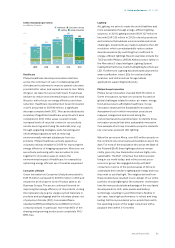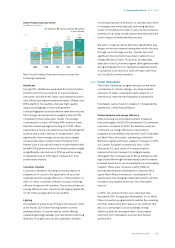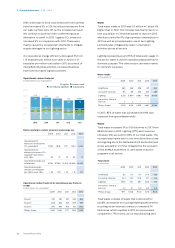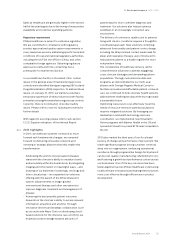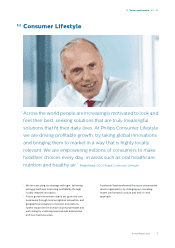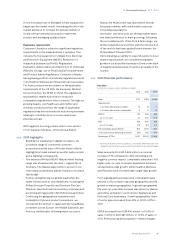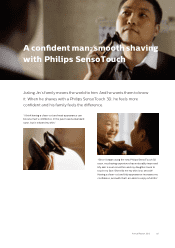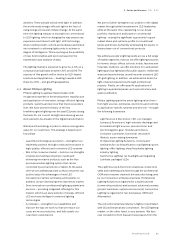Philips 2013 Annual Report Download - page 73
Download and view the complete annual report
Please find page 73 of the 2013 Philips annual report below. You can navigate through the pages in the report by either clicking on the pages listed below, or by using the keyword search tool below to find specific information within the annual report.5 Sector performance 5.1.2 - 5.1.3
Annual Report 2013 73
Sales at Healthcare are generally higher in the second
half of the year largely due to the timing of new product
availability and customer spending patterns.
Regulatory requirements
Philips Healthcare is subject to extensive regulation.
We are committed to compliance with regulatory
product approval and quality system requirements in
every market we serve by addressing specific terms and
conditions of local and national regulatory authorities,
including the US FDA, the SFDA in China, and other
comparable foreign agencies. Obtaining regulatory
approval is costly and time-consuming, but a
prerequisite for market introduction.
In our Healthcare facility in Cleveland, Ohio, certain
issues in the general area of manufacturing process
controls were identified during an ongoing US Food and
Drug Administration (FDA) inspection. To address these
issues, on January 10, 2014, we started a voluntary,
temporary suspension of new production at the facility,
primarily to strengthen manufacturing process controls.
Currently, there is no indication of product safety
issues. Please refer to note 36, Subsequent events for
further details.
With regard to sourcing, please refer to sub-section
13.2.2, Supplier indicators, of this Annual Report.
5.1.3 2013 highlights
In 2013, as healthcare systems continued to move
forward with fundamental changes, we remained
focused on delivering innovative solutions and
investing in strategic alliances that help enable this
transformation:
• Addressing the world’s most prevalent diseases
starts with the clinician’s ability to visualize clearly
and accurately within the human body. By integrating
imaging and information in meaningful ways – and
drawing on our expertise in cardiology, oncology and
other critical areas – we expanded our solutions
oering with the launch of the EPIQ ultrasound
system, advancements in image-guided
interventional therapy and other innovations to
improve diagnosis, treatment and management of
disease.
• Achieving the best possible patient outcomes
depends on the clinician’s ability to access relevant
information, anywhere and anytime. Through
innovative devices and strategic collaboration, such
as our work with Mayo Clinic on developing cloud-
based solutions for the intensive care unit (ICU), we
helped providers manage massive amounts of
patient data for more confident diagnosis and
treatment. Our solutions also helped optimize
workflows in an increasingly connected care
environment.
• The delivery of continuous, quality care to patients
living with chronic conditions requires a thoughtful,
coordinated approach. New solutions combining
advanced functionality and patient-centric design,
including the Wisp minimal contact nasal mask for
sleep and respiratory therapy, were introduced to
help patients adhere to a health regimen for more
independent living.
• The complexities of healthcare delivery call for
comprehensive solutions to address staggering
costs, clinician shortages and demanding patient
populations. Through customized models and
programs, as demonstrated by our multi-year
alliance with Georgia Regents Medical Center to
facilitate innovative and aordable patient-centered
care, we continued to help visionary health systems
address these challenges today while moving toward
a sustainable future.
• Optimizing resources to cost-eectively meet the
needs of resource-intensive patient populations
requires integrated solutions. By leveraging our
leadership in telehealth technology and care
coordination, we implemented new Hospital to
Home programs with Banner Health in the US and
opened eICUs with Guy’s and St Thomas’ Hospitals in
the UK.
2013 also marked the third year of our Accelerate!
journey of change and performance improvement. We
made significant progress driving customer centricity
deep into our organization, embracing operational
excellence through programs like Design for X (where X
can be cost, quality, manufacturing, refurbishment, etc.)
and fostering a growth and performance culture across
our businesses. One of the key outcomes has been
faster alignment across Philips Healthcare in delivering
locally relevant innovations and making these solutions
more cost-eective through efficiencies in product
development.


